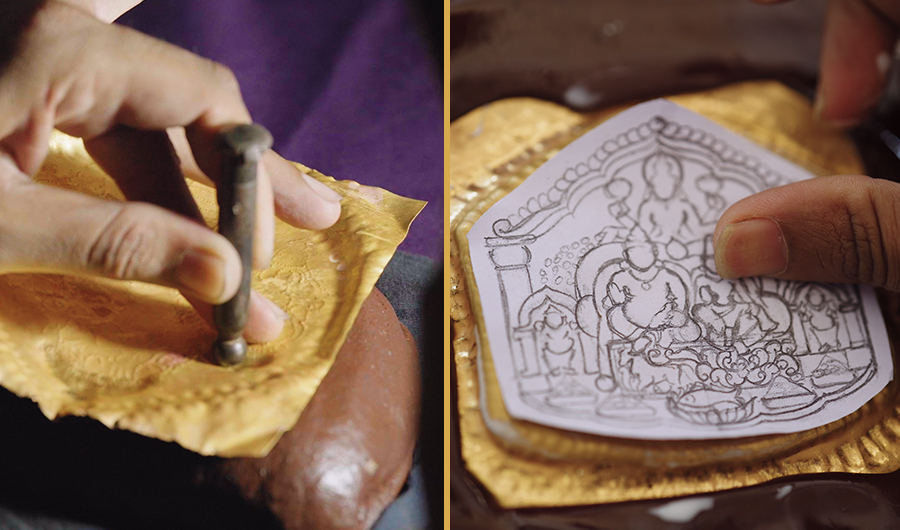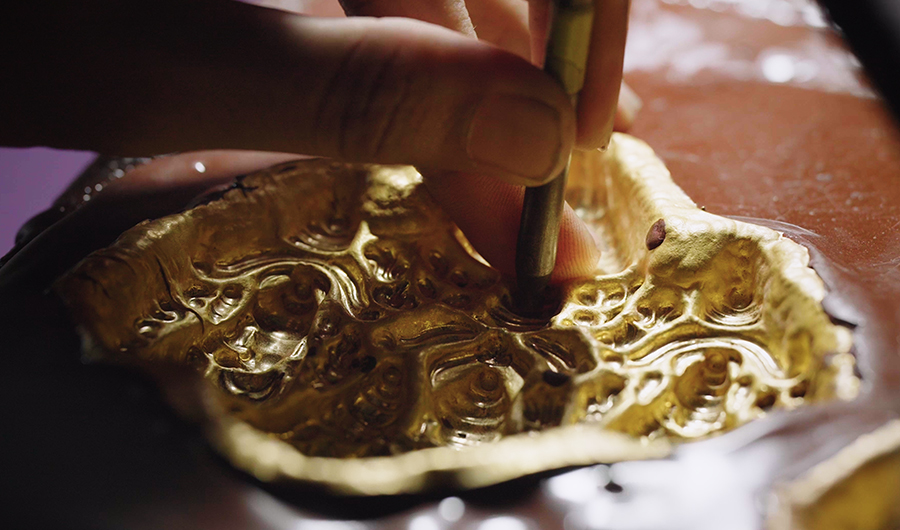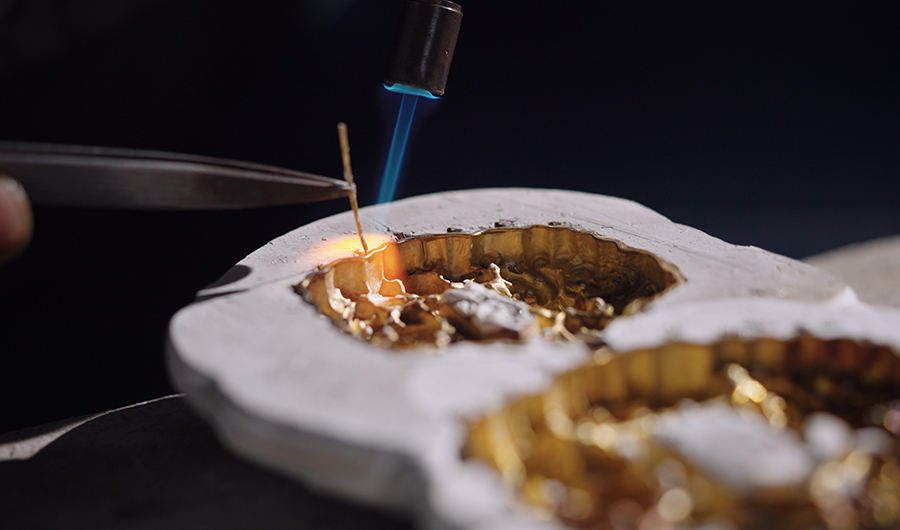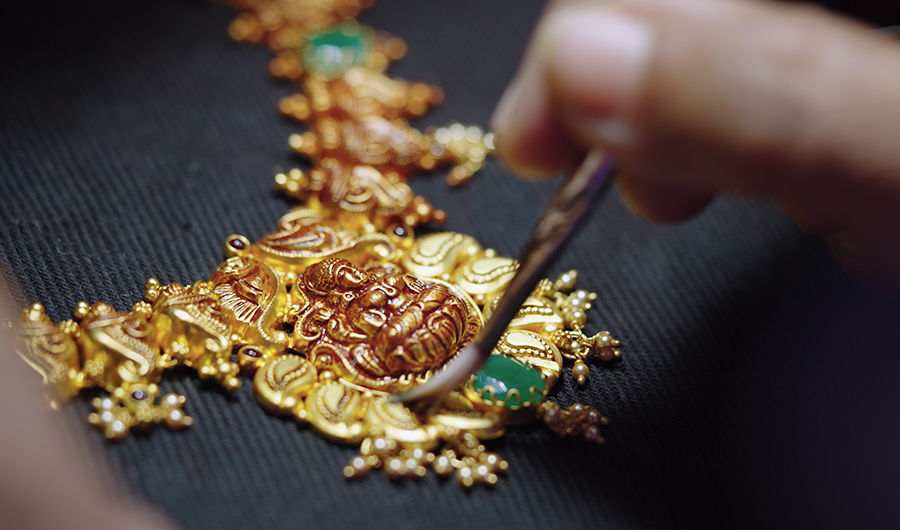Published: 25 Nov 2024
Discovering the Golden History of Nakashi Jewellery

The History of Nakashi Jewellery
Tamil Nadu's tradition of intricate craftsmanship stretches over two millennia and includes several masterpieces. One such work of art is Coimbatore's Nakashi jewellery, which holds profound significance in the state's culture. The gold history of Nakashi jewellery reflects its deep cultural and religious importance, evolving as a symbol of prosperity and devotion through generations.
Nakashi jewellery evolved out of temple jewellery – the traditional jewellery crafted to adorn the gods. Over the years, as jewellery-making developed, these two styles took inspiration from each other to give rise to modern-day temple jewellery.
Find out about the gold history of Nakashi jewellery and the divine yet meticulous process for creating it. Discover its spiritual significance for the Vishwakarma community of artisans and the many exquisite motifs that unfold within these pieces.
Exploring the Gold History of Coimbatore’s Nakashi Jewellery
In several parts of India, gold has always signified wealth, prosperity, and good fortune. Mythologies like that of the Samudra Manthan have also played a vital role in shaping the history and significance of gold in Nakashi jewellery. This influenced the art of jewellery-making in Coimbatore over 2,000 years ago.
With a long-standing tradition of rich craftsmanship, Nakashi jewellery started as artwork dedicated to the Gods. Crafted out of 22 Karat gold and precious stones, these pieces derived inspiration from Tamil Nadu's temples' towering gopurams (entrance towers) and decorated mandappams (sacred areas of ritual).
The tradition of creating delicate temple jewellery for Gods started in the 9th century with the Chola dynasty. Renowned for its patronage of art and architecture, the temple jewellery of this period showcases several Hindu deities. This tradition continued under the Vijaynagar Empire and led to the development of Nakashi jewellery.
Today, the Vishwakarma community is the custodian of this artwork, and most consider it a ritual of worship rather than a vocation. Modern-day women purchase Nakashi jewellery to seek blessings for wealth and prosperity. Antique bridal temple jewellery also adorns several women's ensembles during their special day.
Motifs in Nakashi jewellery: Inspired by Nature and the Divine
Nakashi jewellery, as a type of temple jewellery, derives inspiration from the rich artwork of temple walls. Showcasing snippets from Hindu mythologies, it often has motifs of Gods like Laxmi, Murugan, Krishna, and Vishnu. Over the years, as Nakashi jewellery developed, artisans during the Mughal era started including motifs inspired by nature as well.
These symbolisms that have developed throughout the history of gold used in Nakashi jewellery are not merely decorative. They represent snippets from Tamil Nadu’s rich history. Some of the common motifs you can observe in
Coimbatore's temple jewellery include -
- Depictions of Goddess Laxmi - Considering its close association with wealth and prosperity, motifs inspired by Goddess Laxmi are common in Nakashi jewellery.
- Motifs Related to Lord Shiva and Parvati - These motifs symbolise power and unity, representing the divine balance of the universe.
- Floral motifs - The Mughal influence on temple jewellery made floral motifs an essential part of their design to add a touch of natural beauty.
- Symbolisms for Lord Krishna and Vishnu - Lord Krishna, along with other forms of the God Vishnu, are often included in temple jewellery designs to symbolise elegance and grace.
- Animal symbolisms - Motifs of animals such as peacocks and lions are also common in Nakashi jewellery and symbolise beauty and power.
The process of creating Nakashi jewellery
Passed down through generations of artisans within the Vishwakarma community, the creation of Nakashi jewellery is almost a spiritual process. Artisans consider the practice of creating this temple jewellery to be an act of worship. Each piece is created with reverence, and an intricate step-by-step process is followed -
- Conceptualising and drawing - The design inspiration for Nakashi jewellery is usually found on ancient temple walls. Artisans create detailed design concepts based on the stories of Gods and Goddesses to start planning the temple jewellery set's design.

- Embossing - Once the design has been drawn on paper, it is transferred over a sheet of gold to get an imprint of it through embossing. This creates a skeletal structure of the jewellery set's design elements.

- Detailing - This is one of the most meticulous steps in the process and sets it apart as an act of worship for the artisans. At this stage, artisans painstakingly detail the embossed design with the precise hits of a hammer.

- Soldering - At this point, after several hours of labour, every design element is ready, and the final piece of jewellery is created by soldering the elements together.

- Polishing - Lastly, the artisans polish the newly crafted Nakashi jewellery to highlight the brilliance of its gold and precious stones.

Embracing the legacy of Nakashi jewellery

With such a rich legacy of religious worship and craftsmanship, Nakashi jewellery is a testament to traditional temple jewellery's allure. The history of gold used in Nakashi jewellery not only serves as a record of artistry but is an embodiment of Tamil Nadu’s cultural heritage.
From statement pieces worn on the red carpet to elaborate adornments that create a fusion look, Nakashi jewellery finds a place in almost every woman's wardrobe. Whether it is antique jewellery sets passed down through generations or modern-day designs worn by brides, the spiritual significance of these jewellery designs lives on.











